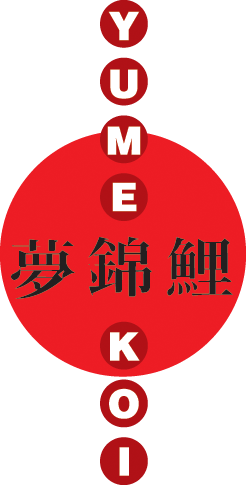Page 1 of 2
These pages will hopefully help you understand our 100% KHV Zero-Tolerance policies, and the methods and reasoning behind the extensive measures we are taking to make sure that our Koi are safe. These pages also explain in extreme depth, how we encountered KHV in July 2006, and what we have learnt about KHV, following the testing of over 1000 Koi because of our problem.
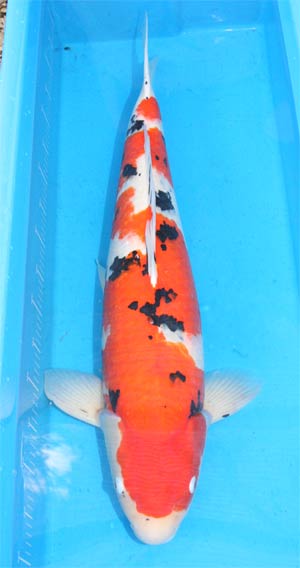 |
In June 2006, we prepared all of our absolute best Koi, as a 'Showcase' to take to the BKKS National Koi Show. All of the Koi that we took, were Koi that we had purchased as Tosai, or Nisai. Some of these Koi had been grown in Japan, and many of them had been grown at Yume Koi. Many of these Koi were of the most extreme high level, a level of which is hard to find, anywhere in Japan, let alone the UK. It took us about three years to get up to this level of Koi. Needless to say, we were incredibly proud to take such Koi to the Show. The 2006 BKKS Koi Show turned out to be our very best result ever! Sure, we had also supplied the Grand Champion and others, that won in 2003, and 2005, but 2006 was really special for us, with John Hellens winning both Grand, and Mature Champions, and Cliff Neale winning Jumbo Champion. In short, we won the top three, out of the top six prizes! The glory however, was short lived... On return from the Koi Show, we put all of our Koi back into their two quarantine ponds, so that we could 're-quarantine' them before moving them back to their relevant growing ponds. We then raised the temperature so that we could get them to our chosen 'growing temperature' of 24c. On the 20th of July 2006, the Sanke pictured on the left, started to breath heavily. Temperture at this point, was 23.5c. This Koi was purchased and sold as Tosai, and was now 74cm, and four years old. She had never left our premises since import from Japan, and we took her to the Show to try to sell her on our clients behalf. |
|
| When I pulled the wonderful Sanke above up for closer inspection, I realised that one side of her gills were damaged. I also found Trichodina and flukes on a gill scrape.My first thoughts with the above Sanke, was that the parasites had damaged the gills, and triggered off Bacterial Gill Disease. I raised the temperature to 27.7c at this point, as 27c will generally fix this ailment relatively easily. I was however, cautious not to raise the temperature higher, just in case it were KHV. This rise in temperature accelerated the Koi's decline in condition, and the Koi died on the eve of the same day. The next two Koi to die, were the two Sanke on the right. Both of these were purchased by us as Tosai. The one with more Sumi was Sansai of about 70cm, and the one with smaller Sumi was one that we grew from 25cm as Tosai, to become 64cm as Nisai. This Koi was one of my favourites, as she was improving at an amazing rate. After these two Koi died, I was starting to become extremely distressed about it, and phoned my good friend Maurice Cox up, and asked if he could come over with some salt (about 11pm at this point). He arrived, and tried to console me by saying that it was possible that it was possiby just parasite damage. Having my doubts, and fearing the worst, I decided to take measures that I knew would stop KHV in it's tracks, with a view to taking the Koi to CEFAS for PCR testing first thing on the following Monday morning. In general, on Sunday the 22nd July, the Koi were starting to look better. At this point, the only mortalities had occurred in the right-hand 1700 gallon pond. Only one Koi in the left pond showed just one very small spot of thick mucous that made me think that this pond was also affected. In the midst of losing the pictured Koi, we also lost three Tosai from the same pond. These Tosai, were from a batch of around 70 that we had received in May 2006, the best 40 of which we selected out, and put into the right-hand pond, to take to the Show. On the morning of setting off to the Koi Show, I decided not to bother with the Tosai, and to take just the 'Showcase Koi' to the Show. |
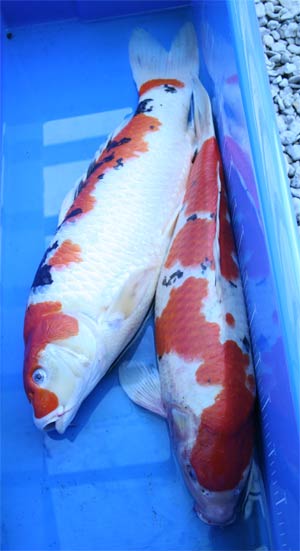 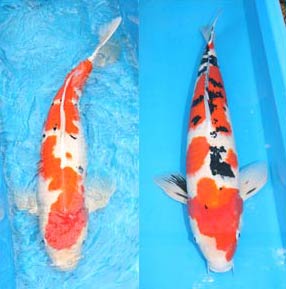 |
|
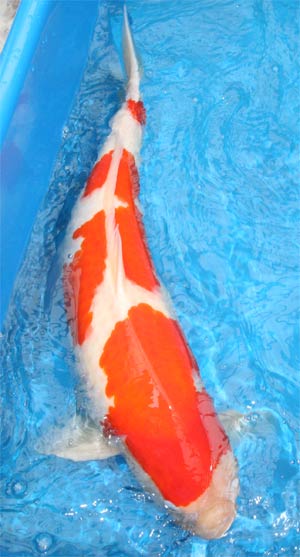 |
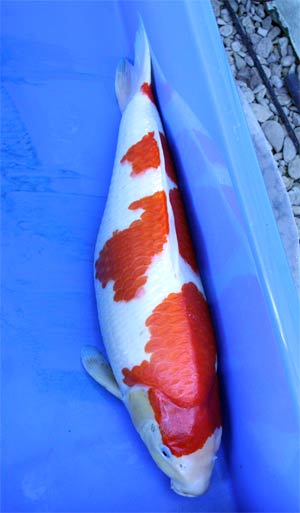 The last Koi to die here, was on the Monday morning, and was this wonderful Kohaku which was in my opinion the best one that we have had here in a long long time. She was 65cm, Sansai, and had perfection in all the criteria that I look for in a Koi to grow big and beautiful. Although we have sold better Koi, this was the best one that we have had here growing at our place. We agreed a sale on this Koi on the 18th July, for her to be grown here. Luckily, she never left the premises. |
|
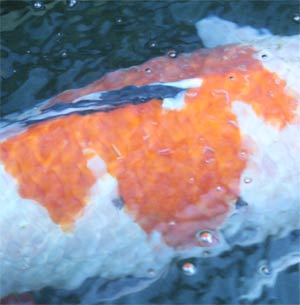 The Showa on the right was showing the classic signs of mucous shedding. The skin also lost its shine, looking grey and dull. The head and face areas also turned dark and patchy. I was convinced that this 75cm Showa would be the last one to die, but within a week of taking steps to stop the spread of KHV, she recovered to look pristine again. It is scary to think, that someone could have visited here on perhaps the 20th July, and again on the 27th (just one week later), and not realised what had just occurred here! Frightening! |
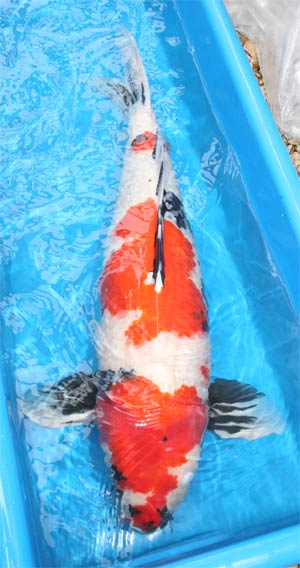 |
|
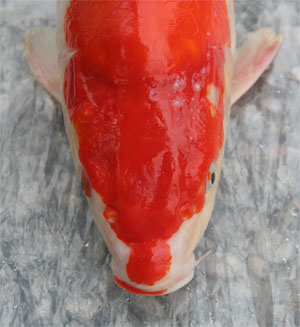 |
On Monday 24th July (2006), we took two dead Koi, and a handful of live ones to CEFAS, so that they could run PCR tests for active KHV, and also anti-body test them by ELISA. From the right-hand pond, we took the Sansai Kohaku pictured above on this page, and a handful of other Koi. From the left pond, we only took a few Tosai. This turned out to be a huge mistake, as you will learn later in these pages. On the 4th August, we received confirmation that the Koi had died from KHV, and that ELISA testing was showing some positives for antibodies. Some of the levels were quite low, as an anti-body response doesn't happen overnight. If a Koi could develop antibodies quickly enough, it probably wouldn't die. This is why a carrier is more likely to survive, than the victims, as it already has some degree of anti-bodies from prior exposure. |
